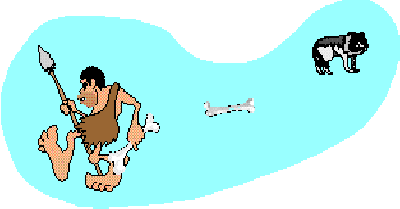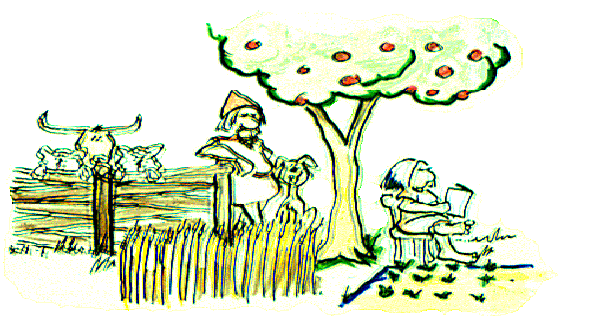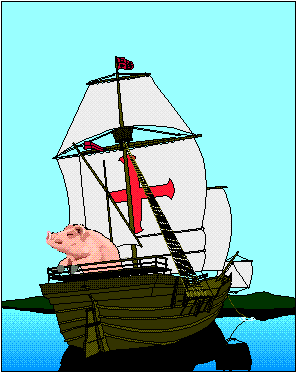How Did Plant Life Impact Animal Evolution

Gordon King, Department of Animal and Poultry Scientific discipline, University of Guelph
"Edible, adj. good to consume and wholesome to assimilate, equally a worm to a toad, a toad to a snake, a snake to a pig, a pig to a homo and a human to a worm." [Bierce, A. The Devils Lexicon.]
 Every living organism is part of a nutrient chain then humans share a necessity to compete straight for nutrients with all other species that are present in the ecosystem. Plants obtain all their essential requirements for maintenance and office by using solar energy to transform unproblematic chemical elements into complex molecules. Animals cannot convert solar energy and so must obtain essential nutrients from other sources.
Every living organism is part of a nutrient chain then humans share a necessity to compete straight for nutrients with all other species that are present in the ecosystem. Plants obtain all their essential requirements for maintenance and office by using solar energy to transform unproblematic chemical elements into complex molecules. Animals cannot convert solar energy and so must obtain essential nutrients from other sources.
Comparison of Survival Strategies for Plants and Animals
Plants are converters of solar energy, requiring merely sunlight, moisture and simple elements to manufacture and maintain their tissues.- Establish success or failure depends entirely on conditions in the surrounding surroundings.
- Under favorable conditions they produce luxuriant growth, reproduce prolifically and mayhap compete with others.
- Unfavorable conditions event in slow or no growth. Some, many or all may wither and die, depending on the severity of the unfavorable weather.
- Plants are not full pacifist just waiting to be abused through deportation past other vegetation or consumption by animals. They bend, thrust and spread to gain advantages over other plants. Some develop sharp foliage edges and thorns while others synthesize unpalatable and even toxic chemicals to discourage consumption by animals.
- Herbivores are the chief consumers, obtaining all nutrients from plants. Some herbivores may exist killed and eaten by secondary consumers who, in plough, could provide meals for higher club consumers.
- Most species of animals are at the mercy of their environment since they must obtain essential nutrients from their surroundings. Nonetheless, many tin drift if local conditions become unfavorable and alternatives are accessible.
- Humans, in dissimilarity to most other animals, accept the mental capacity and manual dexterity to change environments. They exploit plants, animals and the physical earth to satisfy their basic requirements plus many additional desires.
Agricultural Evolution
Eventually, Neolithic tribes took the kickoff steps towards agriculture, discovering that some plants could exist grown from seeds and some animals tamed. This realization that keeping animals and cultivating plants close to the campsite could alleviate the dubiousness of the hunting hunt or foraging trek, provided the first major step in modifying human being civilisation. During the transition from hunter-gatherer to farmer, attending focused on a minor number of species and these became adjusted into a symbiotic human relationship with people. Selected animals were domesticated to provide commodities for consumption by the family group, with surpluses available occasionally for barter or sale to others. In return, humans undertook responsibilities for provision of some feed and care for their livestock, including protection from predators and other potentially pitiful factors.These initial farming efforts, although primitive by electric current standards, freed humans from full dependence on following wild game and allowed establishment of permanent settlements. Once more effective farming practices evolved, some individuals could pursue other activities for at least part of their fourth dimension. Such alternative occupations eventually fostered the gradual transition from archaic to more civilized societies. The history of Man sapiens equally food producers rather than as food procure is relatively recent. In one case established, even so, agriculture reduced the danger of transient or prolonged food shortages and allowed time for other activities. Animal-Human being interactions progressed through a serial of combative to commensal to exploitative stages.

Commensal Stage of Fauna-Man Interactions
The earliest agriculturists kept some semi-domesticated animals to assist in hunting, as pack animals or as a mobile feed reserve.- Animals maintain a loose clan with humans with humans placing few or no restrictions on animals.
- Those animals in association with humans aid in the hunt and warn of potential enemy approach.
- In return, animals receive some share of kills and maybe warmth well-nigh the fire.
-

- This casual clan evolved to situations where humans identify some minor restrictions on animals' freedom but provide small-scale protection from weather extremes and attack by predators.
- Humans realized that animals provide a readily accessible food reserve for apply whenever game or crops fail and that some species posses potential for draft power.
Exploitative Phase of Animal-Human Interactions
 One-time later, actual keeping of livestock specifically as a food source began in tropical or semitropical regions of the Middle East. The early farmers too discovered that whenever h2o was available, crops could be produced during most of the yr. Thereafter, domesticated animals became an invaluable resource with smaller ruminants, pigs and poultry kept for nutrient production and large ruminants providing the power to operate irrigation systems, plows and other farm implements. Additional innovations from antiquity were exploitation of the milk permit down reflex and pick of individuals for prolonged lactation, assuasive evolution of dairying. Besides, the discovery of methods for incubating birds' eggs without nesting hens led to increased availability of poultry products. The Romans recognized and adopted improved farming methods such every bit irrigation systems and oxen fatigued plows encountered in conquered regions. These techniques were subsequently introduced throughout western Europe, along with the Roman-devised crop rotation and dormant systems.
One-time later, actual keeping of livestock specifically as a food source began in tropical or semitropical regions of the Middle East. The early farmers too discovered that whenever h2o was available, crops could be produced during most of the yr. Thereafter, domesticated animals became an invaluable resource with smaller ruminants, pigs and poultry kept for nutrient production and large ruminants providing the power to operate irrigation systems, plows and other farm implements. Additional innovations from antiquity were exploitation of the milk permit down reflex and pick of individuals for prolonged lactation, assuasive evolution of dairying. Besides, the discovery of methods for incubating birds' eggs without nesting hens led to increased availability of poultry products. The Romans recognized and adopted improved farming methods such every bit irrigation systems and oxen fatigued plows encountered in conquered regions. These techniques were subsequently introduced throughout western Europe, along with the Roman-devised crop rotation and dormant systems.  Before 1750 a very substantial proportion of the world'southward population lived in rural areas and engaged in subsistence farming activities. Nutrient supply was never excessive, famines occurred with some regularity, and surpluses were rare, even in the well-nigh flush regions. Such subsistence or near subsistence agriculture still persists in many regions of the world.
Before 1750 a very substantial proportion of the world'southward population lived in rural areas and engaged in subsistence farming activities. Nutrient supply was never excessive, famines occurred with some regularity, and surpluses were rare, even in the well-nigh flush regions. Such subsistence or near subsistence agriculture still persists in many regions of the world.
Shortages of food provided the major incentive for emigration to newly discovered lands and reduced population pressure level in some western European countries. The colonists brought their own livestock with them, introducing new species or strains from Europe into America, Australia, Africa and New Zealand. This was not entirely a one-way exchange. Turkeys, corn (Zea maize), potatoes and tobacco, species previously exploited only past agriculturists in the Americas, were transported back to Europe and eventually spread around the world. An all-encompassing plantation and ranch based agriculture adult in the colonies with a substantial proportion of colonial economy dependent on sending grain and meat back to the mother countries.
Through modern technology, nutrient self-sufficiency or even surpluses resulted in some regions that were traditional importers. Europe no longer needs or wants cereals, meats or dairy products from former colonies and now competes with them to dispose of its ain excess production. This creates many problems including depressed producer incomes, excessive consign subsidies and the demand to develop new trading partners by many countries previously supplying food for EEC members.
The industrial revolution created a wave of urban migration through demand for more than factory workers but also increased productivity of laborers remaining on farms. The first innovations of agricultural importance (1750-1880) produced some mechanized equipment for use on larger farms. Of even greater significance was mass manufacture of improved metal paw implements, making these available at reasonable cost so even peasant farmers could benefit. In add-on, Pasteur's discoveries on preservation or processing were practical to various foods. Too, the development of clipper and afterwards steam ships provided faster maritime shipment for cereals and other durable bolt from the colonies.
Although the do of tilling the soil, growing of crops and rearing of livestock was common throughout parts of Asia, Europe, Africa and fifty-fifty in the Americas for millennia, it has a much shorter history in some other regions. Settlers began moving into southern Ontario, clear cut the forests, establishing farms and displacing the indigenous peoples less than two hundred years ago. The following note provides a brief insight into conditions effectually Guelph at the beginning of the 20th century.
"But seventy years or more have wrought very great changes, both on the appearance of the county and its inhabitants, for it was in the year 1832 and the few following seasons that a great many immigrants arrived and settled in Guelph and the surrounding townships."
"In a few years some of the more thrifty of the settlers possessed a yolk of oxen and a sled, likewise a cow or two, and a few hogs, that fed mostly on beechnuts. These, with a quantity of fowls, kept the larder supplied with such varieties as beechnut fed pork, eggs, and very leaky milk and butter, maple sugar and molasses. Money was very scarce, and when nosotros could sell eggs at 3 pence per dozen nosotros thought information technology a expert cost. But these days and the pioneers have all passed from the changing scenes of the world, having served their twenty-four hours and generation. Simply to them and their successors, all accolade and credit is due, for having changed a dumbo forest into a fruitful garden, and the haunts of the wolf and the comport into homes of peace and plenty, occupies past a refined, intelligent and educated people, both in city and land, who are too in the enjoyment of many of the improvements of an advanced civilisation."
David Kennedy Sr. (1903) Pioneer Days at Guelph and the County of Bruce. Reprinted by the Bruce County Historical Society. 1973.
A more than recent phase in agricultural development (1880-1950) produced further farm mechanization, employed cold storage for long distance transport of meat or processed dairy products and began the awarding of genetic selection for livestock improvement. Simultaneously, the emerging science of agricultural chemistry began contributing substantially to improvements in animal diet. Since 1950, a improve understanding of animate being physiology and ecology requirements, the choice of superior genotypes and the availability of pharmaceuticals at reasonable costs resulted in the evolution of product systems yielding very high biological efficiency. Research programs in the areas of animal production and disease provided the background knowledge necessary for development of efficient product practices that provide consumers with creature products at reasonable prices. An near limitless parade of technical innovations diverted more and more than resources for use by humans, increasing their chances for survival and expansion, often at the expense of other species. One consequence of this progression is that domesticated animals became more and more dependent on people. Humans at present exercise almost total control over livestock activities and should presume full responsibility for welfare.
| Some Major Highlights in the Evolution of Creature Production | |
| Long, long Agone | Small numbers of hunter-gatherers |
| circa eight,000 BCE | Primeval domestication of animals and cultivation of plants. Ancestry of mixed farming. |
| circa 2,000 to 2,000 BCE | River civilizations (Sumar on Tigris-Euphrates; Egyptian on Nile; Indian on Indus; Chinese on Yellowish Rivers. Mixed farming with modest ruminants, pigs and poultry for meat and large ruminants mainly for work. |
| circa 1,000 BCE | Central and South American Indians had mixed farming with turkeys, cameloids, republic of guinea pigs, corn, potatoes and tobacco. |
| 1st century | Romans spread innovations such as the iron share plow, different breeds of livestock and the dormant system throughout their empire. |
| 5th - 15thursday centuries | Dark Ages and Medieval Menses |
| 16th century | Colonization begins and European livestock breeds transported to "New World." |
| 17th century | Formation of scientific societies and breed associations. Europe imports considerable food from colonies. |
| 18th century | Industrial revolution promotes agricultural research, production and storage of forages, establishment of herd books and veterinarian collages. |
| 19th century | Louis Pasteur: agricultural microbiology, chemistry and animal nutrition established every bit disciplines in agricultural colleges. |
| Early 20thursday century | Discipline approach to research and practical awarding of results. Agricultural mechanization, refrigeration, Mendal rediscovered. |
| Mid 20th century | Antibiotics, AI, sire evaluation, more mechanization, move to monoculture, total confinements, European 'exotic breeds' to N America. |
| Late 20thursday century | Biotechnology rediscovered, recombinant DNA products, genetic engineering, interest in sustainable production. |
| 21st century | More emphasis on recycling (less on specialization?). Food surpluses in some regions should lead to reduces government subsidies for surplus generating production. More social club concerns about creature welfare, ecology quality and sustainability. Higher energy costs + questions about consumer preferences=uncertainty! |
![]()
Source: https://animalbiosciences.uoguelph.ca/~gking/Ag_2350/evolve.htm
Posted by: colemancion1967.blogspot.com

0 Response to "How Did Plant Life Impact Animal Evolution"
Post a Comment